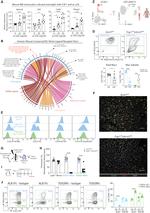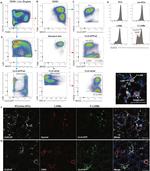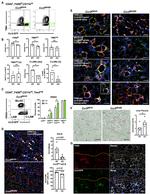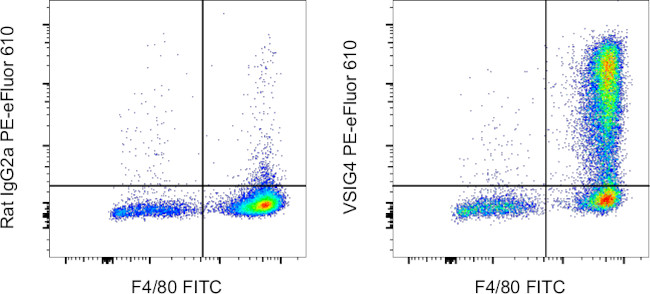Search Thermo Fisher Scientific
Invitrogen
VSIG4 Monoclonal Antibody (NLA14), PE-eFluor™ 610, eBioscience™
FIGURE: 1 / 5
VSIG4 Antibody (61-5752-82) in Flow





Product Details
61-5752-82
Species Reactivity
Published species
Host/Isotype
Recommended Isotype Control
Class
Type
Clone
Immunogen
Conjugate
Excitation/Emission Max
Form
Concentration
Purification
Storage buffer
Contains
Storage conditions
Shipping conditions
RRID
Product Specific Information
Description: This NLA14 monoclonal antibody recognizes mouse V-Set and Immunoglobulin domain containing 4 (VSIG4), also known as Complement Receptor of the Immunoglobulin superfamily (CRIg) or Z39Ig. VSIG4 is a type I transmembrane glycoprotein structurally related to the B7 family of immune regulatory proteins. It contains one complete V-type Ig domain and one truncated C-type Ig domain. VSIG4 is exclusively expressed on tissue resident and tumor infiltrating macrophages. It has been shown to bind complement components C3b and iC3b. This binding inhibits the alternative complement pathway and facilitates phagocytosis of complement-opsonized pathogens. VSIG4 has also been reported to suppress T cell activation, proliferation and IL-2 production thereby playing a role in the maintenance of peripheral T cell tolerance and suppression of established inflammation. Expression of VSIG4 on tumor-infiltrating macrophages suggests its role in immune evasion. Pro-inflammatory stimuli such as TNF and LPS have been reported to down-regulate the expression of VSIG4. Peritoneal macrophages in Balb/c mice express significantly higher levels of VSIG4 than such macrophages in C57Bl/6 or Swiss Webster mice.
The NLA14 antibody will recognize VSIG4 on cells that have been formaldehyde-fixed and permeabilized. This antibody does not block the ligation of VSIG4 to its T cell ligand. The NLA14 antibody does not cross-react with rat or human VSIG4.
Applications Reported: This NLA14 antibody has been reported for use in flow cytometric analysis.
Applications Tested: This NLA14 antibody has been tested by flow cytometric analysis of resident peritoneal macrophages. This may be used at less than or equal to 0.5 µg per test. A test is defined as the amount (µg) of antibody that will stain a cell sample in a final volume of 100 µL. Cell number should be determined empirically but can range from 10^5 to 10^8 cells/test. It is recommended that the antibody be carefully titrated for optimal performance in the assay of interest.
PE-eFluor 610 can be excited with laser lines from 488-561 nm and emits at 607 nm. We recommend using a 610/20 band pass filter (equivalent to PE-Texas Red). Please make sure that your instrument is capable of detecting this fluorochrome.
Light sensitivity: This tandem dye is sensitive to photo-induced oxidation. Please protect this vial and stained samples from light.
Fixation: Samples can be stored in IC Fixation Buffer (Product # 00-8222-49) (100 µL of cell sample + 100 µL of IC Fixation Buffer) or 1-step Fix/Lyse Solution (Product # 00-5333-57) for up to 3 days in the dark at 4°C with minimal impact on brightness and FRET efficiency/compensation. Some generalizations regarding fluorophore performance after fixation can be made, but clone specific performance should be determined empirically.
Excitation: 488-561 nm; Emission: 607 nm; Laser: Blue Laser, Green Laser, Yellow-Green Laser.
Target Information
T cell activation by APCs is positively and negatively regulated by members of the B7 family. VSIG4 is a strong negative regulator of murine and human T cell proliferation and IL-2 production.
For Research Use Only. Not for use in diagnostic procedures. Not for resale without express authorization.
How to use the Panel Builder
Watch the video to learn how to use the Invitrogen Flow Cytometry Panel Builder to build your next flow cytometry panel in 5 easy steps.
Bioinformatics
Protein Aliases: complement receptor of the immunoglobulin superfamily; V-set and immunoglobulin domain-containing protein 4
Gene Aliases: A530061A11; BC025105; CRIg; Z39IG
Entrez Gene ID: (Mouse) 278180

Performance Guarantee
If an Invitrogen™ antibody doesn't perform as described on our website or datasheet,we'll replace the product at no cost to you, or provide you with a credit for a future purchase.*
Learn more
We're here to help
Get expert recommendations for common problems or connect directly with an on staff expert for technical assistance related to applications, equipment and general product use.
Contact tech support

